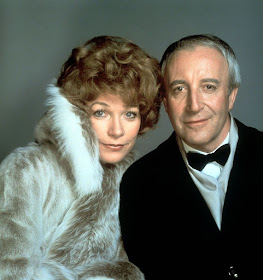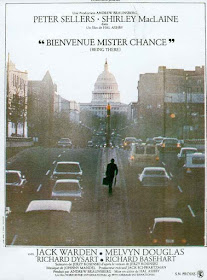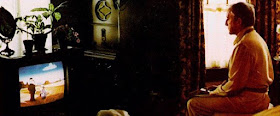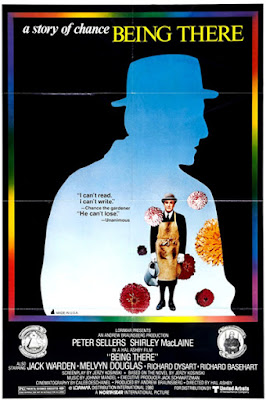 ‘The Criterion Collection’ have recently released a digitally enhanced version of ‘Being There’. It was directed by Hal Ashby; it starred Peter Sellers, Shirley MacLaine, Melvyn Douglas, and Jack Warden; and it lasts for 130-minutes. Plus, as an extra added bonus, the Blu-ray edition comes with a new documentary about the film, the original theatrical trailer, a promotions reel, a deleted scene, outtakes, an alternate ending, as well as interviews with Hal Ashby, Jerzy Kosinski, and Peter Sellers. Please enjoy.
‘The Criterion Collection’ have recently released a digitally enhanced version of ‘Being There’. It was directed by Hal Ashby; it starred Peter Sellers, Shirley MacLaine, Melvyn Douglas, and Jack Warden; and it lasts for 130-minutes. Plus, as an extra added bonus, the Blu-ray edition comes with a new documentary about the film, the original theatrical trailer, a promotions reel, a deleted scene, outtakes, an alternate ending, as well as interviews with Hal Ashby, Jerzy Kosinski, and Peter Sellers. Please enjoy.Being There (The Criterion Collection)
THE STORY:
Who is Chauncey Gardner (Peter Sellers)? Seriously, who is he? Because not much is known about this man since he first arrived in Washington, D.C. a few nights ago. Apart from the fact that he likes gardening, is friendly with the wealthy businessman, Benjamin Rand (Melvyn Douglas), and has recently been quoted by the President of the United States (Jack Warden)!
Well, according to our sources, Chauncey met the President through Ben, a day after he had an accident with Ben’s wife, Eve Rand (Shirley MacLaine). A fairly minor traffic accident which resulted in an injury to his leg. But aside from that? Nothing much more is known about Chauncey. Nothing about his family life. Nothing about his personal history. And nothing about where he came from prior to his encounter with Eve.
So, if anyone has any more information about him, then please feel free to contact us here at the studio so we can discuss this matter further. Otherwise, what next transpires may go to Congress when the White House suddenly turns green. As a mystery slowly begins to darken - a wife’s confusion deserves a solemn pardon - a friend's death leads to a shot at stardom - and at the end of the day, please remember, everything will be just fine in the garden.
THE REVIEW:
To me, ‘Being There’ is a film about perception. Or to be more specific about it, how we can all look at life in a variety of different ways. To some, life can be harsh, cruel, and damn right mean. Whereas to others, it can be a glorious thing of beauty to constantly cherish and crave. As for me, though? Well, as far as I’m concerned, life can be about both of these things as well as how we cope with constant change. Change to our environment. Change to those around us. And change to how we look at the world from day to day.
For instance, when I first saw this film (in my mid-twenties), I didn’t like it because Peter Sellers wasn’t performing a variety of funny accents, Shirley MacLaine looked like a glamorous version of my Mum, and the overall story was too slow and too political to follow (two things that I wasn’t too keen on at the time). But now, now I’m a little older and a little more astute with my opinions, I like it, I like it a lot, because it’s a fairly funny film that’s well crafted and works on three specific levels. On one level, it’s a political film, describing the financial side of American politics and how that can directly affect the cultural climate. On another level, it’s a sociological film, focused on the media and how they can manipulate the public through the nature of celebrity. And on yet another level, it’s a film about perception, mental health, and spiritual growth, all filtered through a simple-minded individual who eventually manages to obtain a position of power.
Now, the way it goes about doing this; is by defining four key characters that feed off of each other in a fairly understated fashion. First, there’s Chauncey, the hero of our story, who has no personality and no academic credentials whatsoever. Then there’s Eve, the token love interest, who introduces Chauncey to ‘her world’ and slowly gives him the opportunity to explore it. Next, there’s Robert, the pseudo-detective, who manages to unlock a portion of Chauncey’s past and then link it to Eve‘s future, all the while acting as a liaison/doctor/friend to the fourth character on our list. Benjamin, Benjamin Rand, the rich businessman, who’s Eve’s elderly husband, Robert’s ailing patient, and Chauncey’s gateway to American politics and celebrity.
So, as you can see, from a narrative point of view, there’s a certain amount of dynamic synergy flowing between these four characters, synergy which allows them to push the plot forward in four progressive stages. Stage One, sets up Chauncey’s character and alludes to his backstory. Whereas Stage Two, establishes his relationship with the Rand family and their subordinates. Stage Three, on the other hand, sees Chauncey coming into contact with love, death, politics, and the cult of celebrity. And as for Stage Four? Well, this is where the moral of the story finally bites the bullet and tells us what it's all about: It’s about a quote taken from the bible, Matthew 5:5, which states, ‘Blessed are the meek, for they shall inherit the earth’.
But then again, I could be wrong (and most probably am), because it's entirely possible that this film is about something completely different. Something about a simple man who doesn’t emotionally connect with the people around him and is obsessed with gardening, watching television, and an orderly routine. In fact, Chauncey’s 'obsessive tendencies' are so apparent on occasion, sometimes, it’s pretty difficult to take his ‘happy accidents’ very seriously. After all, someone misinterpreting his statements once or twice does seem fairly plausible! But more than that? No, I don't think so, due to the fact that repetition can make things feel forced and fairly formulaic the longer it's played out (similar, in part, to those scenes where certain characters would comment on Chauncey’s so-called ‘animal magnetism’, which likewise grew moderately weary upon repetition).
Aside from that, though, all in all, I’d say this movie is a marvelous movie, and it comes with some fairly fantastic facts. Here, check them out: (1) ‘United Artists’ first released this $7 million production in New York, New York, on the 20th of December, 1979, and eventually clawed back $30.2 million at the Box Office. (2) This film was based on a novel of the same name written in 1970 by the author, Jerzy Kosiński. (3) Loosely translated, this project was entitled ‘Welcome, Mr. Chance!’ in Finland, ‘Presence’ in Bulgaria, and ‘From the Garden’ in Peru. (4) It took Peter Sellers approximately nine years to get this movie made because no major Hollywood studio wanted to hire him due to his chequered career. In fact, the only real reason Peter was able to star in this cinematic adaptation, is because of his success in the 1978 hit comedy, ‘Revenge of the Pink Panther’. (5) The majority of this movie was shot on location throughout the United States of America. This includes The Craven Estate and The Fenyes Mansion in Pasadena, The Biltmore Estate and Buncombe Technical College in Asheville, Mount Baker and 937 M Street NW in Washington, as well as select shots taken within the surrounding areas, including Maryland. (6) In an interview he gave to the press, Peter Sellers told a journalist that he disliked the outtakes featured at the end of this film because he thought they ‘broke the spell’ and cost him an Oscar nomination for 'Best Actor'. (7) One of the taglines used to promote this picture, states, ‘Life is a State of Mind’. (8) This was the last time Ruth Attaway and Richard Basehart would appear in a major motion picture because Ruth retired after it was completed and Richard mainly focused on television work for the rest of his career.
In closing my review of 'Being There', I’m now going to rank each key performance in order of preference. So, at the top of my list, I’d like to select the star of the show, Peter Sellers, because he portrayed Chauncey Gardner as if he were an autistic version of Stan Laurel, but with a stoic edge, a quiet demeanor, and a stillness that was rather dynamic to behold. Up next, I’d like to single out Shirley MacLaine and Melvyn Douglas who played Eve and Benjamin Rand respectively. Although, in their case, my adulation stems from the way they depicted their characters as if they were nice and respectable people, despite both of them possessing a number of notable flaws. In Eve, it's featured in her desperation and her coquettish characteristics, and in Benjamin, it's exhibited through his brand of dignified righteousness that's one part intellectual and one part presumptuous. And as for the rest of the cast? Well, more or less, most of them did a pretty decent job, including Jack Warden, who played the President of the United States as an uptight impresario, as well as Richard Dysart, who played Dr. Robert Allenby so convincingly I honestly thought he was a real doctor.
 Come to think of it, this last point brings me quite nicely on to something else I want to talk about. Namely, Peter's convincing depiction of Chauncey Gardner, even though we don’t discover very much about him. After all, his medical condition was never revealed (presumably, it’s some form of autism), his family history was never expanded upon (although it's insinuated that the ‘old man’ who died at the start of the film may be his father), and his obsession with television, gardening, and mimicry was never explained (keeping in mind that he lacks the ability to emotionally connect with the people around him). In addition to this, I would also like to applaud the visual style of this film, particularly how it perfectly synchronized with the music that accompanied it. Aesthetically, everything seen on screen is bold, clear, and nicely framed, whereas acoustically, most of the songs harmonized in the background nicely enhanced the intent of the scenes being played in the foreground. Here, check out the following video clip to see what I mean…
Come to think of it, this last point brings me quite nicely on to something else I want to talk about. Namely, Peter's convincing depiction of Chauncey Gardner, even though we don’t discover very much about him. After all, his medical condition was never revealed (presumably, it’s some form of autism), his family history was never expanded upon (although it's insinuated that the ‘old man’ who died at the start of the film may be his father), and his obsession with television, gardening, and mimicry was never explained (keeping in mind that he lacks the ability to emotionally connect with the people around him). In addition to this, I would also like to applaud the visual style of this film, particularly how it perfectly synchronized with the music that accompanied it. Aesthetically, everything seen on screen is bold, clear, and nicely framed, whereas acoustically, most of the songs harmonized in the background nicely enhanced the intent of the scenes being played in the foreground. Here, check out the following video clip to see what I mean…Overall, I would just like to say that I really enjoyed watching this film, and I would highly recommend it to people who are fans of political satire, psychological dramas, and stories that make you think about the world around us.
THE RATING: B+
BEING THERE (1979)
 Reviewed by David Andrews
on
January 06, 2020
Rating:
Reviewed by David Andrews
on
January 06, 2020
Rating:
 Reviewed by David Andrews
on
January 06, 2020
Rating:
Reviewed by David Andrews
on
January 06, 2020
Rating:







No comments:
Post a Comment